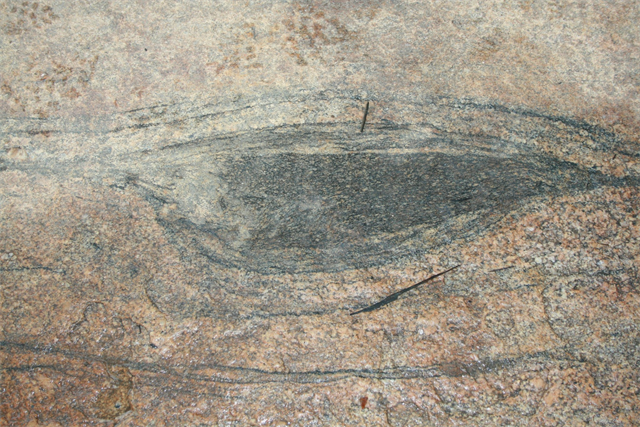Xenoliths and Schlieren EarthCache
-
Difficulty:
-

-
Terrain:
-

Size:  (not chosen)
(not chosen)
Please note Use of geocaching.com services is subject to the terms and conditions
in our disclaimer.

Coming from Greek "xenos" (foreign) and "lithos" (stone). Xenoliths of this location are found within an igneous intrusion, which is unrelated to the igneous body in which the intrusion is occurring*. In a more generalized understanding, xenoliths represent segments of the “country rock” that is incorporate into magma while the magma is still fluid. Xenoliths can either be settled in position once plucked from their “country rock” or can transported away from their origin.
- If the “Country rock” density is greater than that of the new magma the xenolith will settle deep within the intrusion.
- If the “Country rock” density is less than that of the new magma the xenolith will be transported further up the intrusion.
Geologist extrapolated the "country rock" in this location was a metamorphic granite type called schist. These rocks form under high P/T conditions that aligns the minerals into thin layers, or foliation. These foliation lines can still be seen in the xenoliths today. Creation of the petersburg granite was initiated either by a dike or a sill of a felsic (light coloured) pluton during the accents from the mantle to the lithosphere.
As the magma cools, xenoliths are typically reconstituted via contact metamorphism. As a result of the contact metamorphism partial melting of the “country rock” occurs. This creates as one is able to notice long dark “lines”. In geology one calls this feature schlieren (german for line) and in this case are bands of mafic (dark) and felsic (light) and generally in the region one finds more proportion of mafic than the felsic. If one is able to study and gain enough information, a geologist can determine the temperature and composition of the intrusion.
*Note of interest:
When similar rocks intrude one another, one labels the as "autoliths" or "cognate inclusions".
Bernoulli Principle in it's simplest form dictates the direction of travel via mean of pressure in a liquid or gas medium. Many have experienced this effect through traveling in a car and extending ones hand and arm out the window to create a "wing". As an object interacts with the medium the pressures within the medium changes to either high or low pressures. Depending on the angle of these forces on the various surface angles will both pull and push the object. Distances between the schlieren will allow one to determine the forces as they once were. Further apart or wide schlieren are high pressures and narrow schlieren represent low pressure.
To prove you visited this area, send an email with the following information.
1. In which direction are the schlieren?
2. Find three or more xenotliths and obtain the GPS addresses
3. How do you think the magma flow was in this intrusion? (use the concept of The Bernoulli Principle to calculate travel)
Below are some examples one can find near the EarthCache Coordinates.




Additional Hints
(No hints available.)